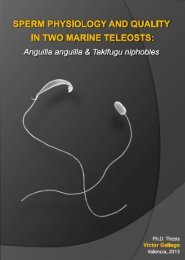Vista/Abrir - RiuNet
Vista/Abrir - RiuNet
Vista/Abrir - RiuNet
You also want an ePaper? Increase the reach of your titles
YUMPU automatically turns print PDFs into web optimized ePapers that Google loves.
Abstract<br />
Solute dispersion processes in porous media remain as a subject of research due to both<br />
the limitations of available mathematical approaches, and to the need of properly<br />
reproducing the real patterns of the medium heterogeneity. Yet, building models able to<br />
accurately predict transport processes in real formations require dealing with dispersion<br />
processes. Assuming that the classical Advection-Dispersion Equation (ADE) is valid at<br />
some fine scale referred to as Representative Elementary Volume, two main and<br />
important research lines are identified. The first focused on the average ad effective<br />
dispersivity parameter that allows reproducing a solute plume development using the<br />
ADE. As a plume evolves, it flows through different heterogeneities, each of them with<br />
its own effect on the plume. These make the dispersion parameter value to increase until<br />
reaching an asymptotic value. But, different studies show that dispersivity does not<br />
reach an asymptotic value possibly due to the combined effect of different scales of<br />
hydraulic conductivity (K) heterogeneity and to the non-Fickian behavior of transport.<br />
A second line assumes the importance of properly modeling K at different<br />
scales, and that non-Fickian features can be approached by modeling heterogeneity<br />
occurring at very fine scale. Then, some mathematical approaches, such as the multirate<br />
transport formulation, allow incorporating the effects of this fine scale heterogeneity in<br />
a coarse scale, using effective values of dispersivity. Besides, the spatial variability os<br />
this parameter is not addressed in this approaches; only K variability is accounted for.<br />
Both points of view focus on a unique parameter in order to explain the<br />
deviation of real plume behavior from ADE predictions. This parameter is the<br />
heterogeneity of hydraulic conductivity, K. No attention is given to the heterogeneity of<br />
dispersivity distribution. The difficulty to estimate this parameter, and its scale<br />
dependence, has limited the number and scope of reseachs. Though is usual to estimate<br />
an average value for dispersitivy, these methods are not able to predict the details of<br />
local heterogeneties on the plume shape or velocity.<br />
This research is based on a solute transport intermediate scale experiment in<br />
which local and instantaneous values of dispersivity are estimated, using a laboratory<br />
tank. The available means for data monitoring, acquisition and process avoid to gather<br />
exhaustive information of the evolution of a tracer plume evolution experiment. Current<br />
researchs have focused on estimating the dispersivity value using the spatial moments<br />
method or breakthrough curve analysis, mostly to verify different stochastic theories. In<br />
this research, we have built an artificial porous media, within a quasi-2D tank, with<br />
patterns of heterogeneity based on K data from a real non-Gaussian formation (MADE-<br />
2 site, Columbus Air Force base, Mississippi, USA). By controlling the head gradient<br />
between both ends of the tank (1,2 meters long, 0,40 high and 0,05 m deep) steady state<br />
iii
















